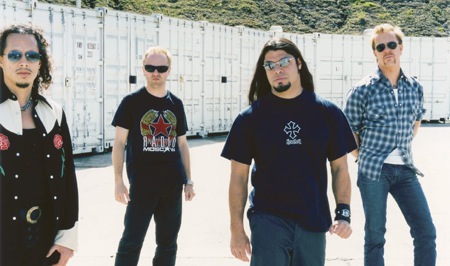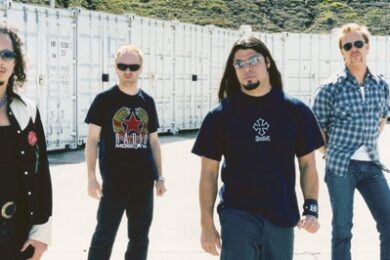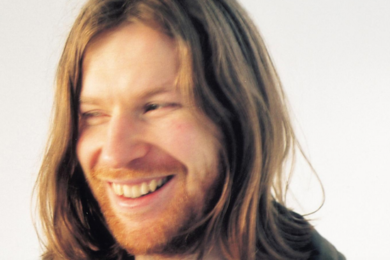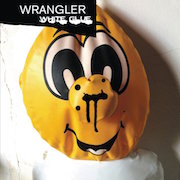Seeing as we’re not allowed to tell you that Metallica’s new album sounds like . . . And Justice For All, we’re not supposed to mention that one of the songs on the album may or may not be called Flamingo and we’re certainly 100% most definitely not supposed to suggest that the new record might possibly be good, we thought we’d treat you to an interview with the group back when they released . . . And Justice For All. Which the new album may or may not sound like. We really couldn’t comment.

Ulrich has recently risen from the sleep, dreamless or otherwise, of the very successful. His band, billed fourth (between Led Zep wannaboys Kingdom Come and metal morons Dokken) on the Monsters or Rock tour " a.k.a. the "Fucking Monsters of Fucking Rock" tour, a.k.a. the "weekend" tour " has garnered at least as much critical oom-pah as their co-"Monsters," even Van Fucking Halen.
During their non-touring weekdays, Metallica was ensconced in the bucolic environs of Woodstock, New York, feverishly mixing tracks for their fourth LP, …And Justice for All!. Ulrich doesn’t remember that the studio where they’re working is named Bearsville; he only knows that it’s several miles from the nearest watering hole. But when bleary-eyed singer/guitarist James Hetfield joins us a little later, he’ll helpfully add, "It’s out in the middle of the forest up there. I heard something about The Band."
Ulrich and Hetfield formed Metallica in Los Angeles in 1981 as a hard-edged response to late-Seventies mainstream rock. Inspired in equal parts by the so-called "new wave of British heavy metal" and by the Southern California hardcore scene, Metallica stripped away the gothic excesses of the former and expanded the shortform song structures of the latter to produce five- to eight-minute mini-epics of ear-shattering volume and mind-boggling speed. They compounded multiple riffs within single tunes, linking them with subject matter that rejected "gonna-rock-ya-all-night-long" HM cliches (not to be confused with "gonna-love-ya-all-nite-long" HM cliches) in favor of darker meditations on power, violence, aggression and death.
Young and hungry, Metallica evinces absolutely no influence prior to, say, 1976. For example: an AOR "oldies" station plays quietly in the background as we talk. At one point, a strange expression passes across Hetfield’s face. He looks at the radio and, almost complaining, asks, "What’s this?!" The scrap that caught his attention was Leigh Stevens’ guitar solo on Help Me Doctor from Blue Cheer’s first LP, Vincebus Eruptum " arguably the finest heavy metal album ever recorded.
Rather than subsisting as just another metal band from L.A., the group, which included lead guitarist Kirk Hammett and bassist Cliff Burton, moved to New York in 1983. After signing with Megaforce, they released their first LP, Kill ‘Em All, whose leather-roots popularity kept them on the road in the United States and Europe for the next nine months. The band’s second Megaforce LP, a post-adolescent death trip titled Ride the Lightning, was quickly snatched up by Elektra and went on to sell more than half a million copies. As to the record’s morbid theme, Ulrich says, "around then we were talking about capital punishment and had a lot of fucking thoughts about dying and death."
"We were putting ourselves in various situations," adds Hetfield, "like the electric chair and cryonics."
Both make a big deal about how none of their records, including Lightning, is a concept album. "I think records reflect whatever shit you’re going through at that point in time," noted Ulrich sagely.
With the success of Lightning, Metallica’s stock quickly ascended. They were still a cult band, but they were a cult band like Pee-Wee Herman is a cult comedian. By the time Elektra released Master of Puppets in 1986, Metallica had welded shut their position in the metal pantheon, despite the fact that virtually no radio station dared to air their savagely sophisticated megawattage and they made no music videos.
Collectively, Metallica’s members thrive on their independence and outsider status, scorning anything short of total musical and personal autonomy. Ulrich describes Puppets, for example, as being about the dangers of "drugs, manipulation, anything that takes you over". The lyrics’ syntax may scan in the most bizarre of fashions " just try and parse lines like "Not dead which eternal lie/Stranger eons death may die" " but the impact and emotion is unmistakable. What do you expect from a metal band, after all. Cole Porter?
An American tour with Ozzy Osbourne following the release of Puppets nailed their appeal. The album has since sold more than 750,000 copies domestically and penetrated Billboard’s Top 30.
Sadly, bassist Cliff Burton was killed in Scandinavia when the band’s tour bus crashed that summer. Rather than fade into oblivion, however, the band resuscitated itself in his honor and added bass player Jason Newsted (of Flotsam & Jetsam fame). After touring Japan, they even returned to Europe and made up the dates they’d missed.
Back home, a miserable experience in a Marin County rehearsal studio (could you perform with Night Ranger playing on one side of you and Starship on the other?), followed by Hetfield seriously messing up his arm in a skateboarding mishap, slowed Metallica’s recording momentum. But while their wounds healed, the group found time to knock out its second collection of loose ‘n’ lively cover versions (the first, 1984’s Garage Days Revisited, was available only as an import). The $5.98 EP: Garage Days Re-Revisited is a six-song grab bag of metal classics by the mainly lame likes of Holocaust, Diamondhead, Budgie, the Misfits and Killing Joke. Hatched in Ulrich’s San Francisco garage, the EP was recorded in Los Angeles in six days " "about the same time it took a load in the gear on the last album," according to its liner notes.
For Metallica, writing and recording an album is an extremely piecemeal, even abstract process. Their songwriting begins literally in a garage, which Ulrich and Hetfield sift through riff tapes compiled by the four band members.
"We’ve got riffs from years and years," explains Hetfield. "On the road we constantly riff and write it down."
"The riffs have feels," says Ulrich. "First we start separating the riffs into… "
"…Categories… " says Hetfield.
"Like, some shit is strong enough to be the main idea of a tune. Then we go through the tapes and try to find possible bridges, choruses, middle bits or whatever. After we have the skeleton of a song, we start getting a feel for what the song’s really like. Then we search for a title from a list of titles that fits with the riffing’s mood."
After assembling the song, the group works it out on a demo.
Hetfield: "Then Lars and I sit with the demos and go, Well, this is a little too fast here, and this is little too slow. We’ll play it live and see if it really grooves. If not, we’ll try it a little faster."
Ulrich and Hetfield next assemble a click track that schematizes the song’s various tempos.
Hetfield: "First I’ll lay down a scratch rhythm, then he’ll go in and do his drums. I think our click track situation is something unique from what other bands do because some songs have between 10 and 15 click-track samples, which really freaks people out. They can’t understand it. Usually clicks keep the time steady, but we have many moods and grooves within each eight- or nine-minute song. So for every riff we figure out what tempo it sounds best at, to make it fit better with the whole thing’s overall feel.
"Putting down the clicks for a couple of songs on Justice! took two days each. But when I tell that to other people they think I mean two hours or something."
After completing the click track, the group is ready to record. Here again Metallica differ from standard procedure by going after a full, "live" sound in the most roundabout of ways.
"We record about as nonlive as possible," says Ulrich. "There’s never more than one guy in the studio at any one point in time."
Building the click track, says Hetfield, takes "a lot longer, probably, than it would to actually do it live". The recording procedure goes something like this: Hetfield lays down his scratch rhythm, Ulrich records his drum tracks, Hetfield returns and completes his final rhythm-guitar parts, Newsted adds the bass, then Hetfield and Hammett alternate leads and vocals, "so we don’t burn ourselves out".
…And Justice for All! was recorded at One on One Studios in North Hollywood. Deciding what studio to use has become one of the most important facets of the Metallica recording strategy, and the group spares no expense in finding a place with the most precisely sympathetic "vibe".
"We’re very conscious of studio atmosphere," confesses Ulrich. "More so than whether it has one or two AMSs. When we decided to make the record in L.A., me and James went down there for about a week and the record company set up a tour of all the studios." They’d done something similar with Puppets three years before, "but there were so many updates and changes since then, both in the way we looked at things and in the way studios were functioning, we thought we’d better do it again."
Having recorded most of The $5.98 EP at Conway in Los Angeles, Metallica hoped to use it again. Unfortunately, says Ulrich, "there’s a producer who sits on it all year round." Ulrich and Hetfield had almost given up on finding the perfect studio when they (literally) stumbled upon One on One.
"We came to the studio about 10 in the morning," recalls Ulrich, "and we were really hung over. The people who worked there must have thought we were fuckin’ drunk idiots or something. We walked in and kind of took one look at the place, went through every room, checked out the control room, and then just turned to each other and nodded. When we walked out, there was a phone in the corner and I ran over, called out manager, and said, We need three months in the studio starting January 30th, now. It was just like a very sort of instant thing, which I think was really cool.
"It was funny because the night before we were drinking with [Def Jam mogul] Rick Rubin, and we were complaining about how we’d been in L.A. for five days and were getting really pissed off with it. There were certain things we look for in a studio " atmosphere, the size of the control room, equipment (obviously), the lounging department, the size of the recording rooms, sound, that there’s only one studio and so forth " but every studio we went to had one or two things that were fine along with three or four things that weren’t. But One on One had all those things together."
Ulrich criticizes the business-oriented sterility of most Los Angeles studios, "You walk in and there’s eight secretaries, computers and fuckin’ fax machines. I know this stuff is necessary, but there comes a point where it’s too much. They’re like music factories, if you know what I mean." Likewise, "With most of the L.A. studios you have to fuckin’ rent everything, from a tambourine to fuckin’ rent mallets. It’s weird. It seems like there must be payoffs or something."
One on One, on the other hand, was an "easygoing" studio that catered to the band’s needs in every department. They also appreciated such built-ins as the computerized SSL 4000 board as well as "your basic AMSs, your reverb shit, and your fuckin’ equalizers. It had a lot of old equalizers taken out of an old Neve board, which is pretty cool."
Metallica’s last two LPs were recorded in Copenhagen’s Sweet Silence Studios. One of the differences between most studios in Los Angeles and their European equivalents, says Ulrich, is how "all that shit’s included. You don’t have to fucking rent anything." Another difference is the tendency of European studios to employ an in-house engineer, which is how the group discovered Flemming Rasmussen.
During their ’84 European tour, the band decided to concentrate their energies on an extended stay on the continent, where they could tour, record an album, blitz the press and "really spread a lot of shit around."
They met the man with whom they would record their next three albums during their first day in Sweet Silence Studios. "Flemming had done some Rainbow stuff that sounded pretty good and he was supposedly a really happening engineer," recalls Ulrich. "At that point in time we had had a really bad experience with an I-use-the-term-loosely ‘producer’ on the first album [Paul Curcio on Kill ‘Em All], and we were glad to have two more weeks of studio time instead of spending $10 or $15 thousand on someone who really didn’t know anything about the band. So we went in and did it with Flemming, and instantly there was some sort of happening vibe there. There still is, and it’s been growing stronger, really. He’s like the fifth member when it comes to recording."
Unfortunately, Rasmussen wasn’t immediately available after Metallica began recording …And Justice for All!, so the band hooked up with Guns N’ Roses producer Mike Clink for their first sessions at One on One. On Master of Puppets, according to Ulrich, "we booked studio time and fucking got all the decisions together way too early in the songwriting. But when it came time to go into the studio, we weren’t really ready." With Justice!, however, the situation was exactly the opposite.
"This time around we didn’t want to make any recording decisions until we had all the songs written. So we started writing in October and it only took eight or nine weeks to write the songs. It went a lot quicker than we thought it would." By January, they were ready to record, but Rasmussen wasn’t, having been unavoidably detained by a prior commitment to a band amusingly called Danish Pregnant Woman. But Metallica wanted him bad, and did everything in their power to snare him, but to no avail.
"We fucking tried everything, but there was no fucking way to get this fucking Danish Pregnant Woman to fucking give Flemming up. We offered to fucking fly engineers in at our expense, pay for studio time, anything, right? No. See ya.
"So basically we were faced with the situation of whether we wanted to sit around and dwell for fucking three months, let the fuckin’ songs get burned out, and kind of fuckin’ start hating things. We’re all sitting around on our couch going flump, we’ve gotta fuckin’ start doing something with out time."
The decision was made to go into the studio with Mike Clink, get comfortable by wailing on a couple Diamondhead and Budgie chestnuts, work out some B-sides and prepare for Rasmussen’s availability. But, according to Ulrich, "The Clink situation emphasized that we really can’t work, or at least record, with anyone other than Flemming."
"Well, we can." Adds Hetfield, "but it’s a slow process."
"We’d still be in there right now doing drum tracks," moans Ulrich.
Rasmussen finally came to the rescue, and the drummer and guitarist acknowledge that their time with Clink wasn’t totally wasted. Rather, it was just enough to loosen the group up and enable them to start recording within a couple of days of Rasmussen’s arrival six weeks into their studio block. "If we’d started from scratch it probably would have taken us three weeks," says Ulrich.
Metallica mixed …And Justice for All! with Michael Barbiero and Steve Thompson, who credits include Whitney Houston, Madonna, the Rolling Stones, Prince, Cinderella, Tesla and Guns N’ Roses. Ulrich and Hetfield are optimistic about the collaboration.
"Looking back," opines Ulrich, "I don’t think we’ve been too comfortable with any of the mixes we’ve ever done."
Hetfield agrees, adding, "I think the problem with a lot of people who specialize in mixing is they set up the mix the way they’re used to mixing bands, and everyone ends up sounding like those mixes. What’s great about these guys is they go out of their way to keep the band’s identity completely together."
How does Justice differ from Puppets?
"It’s a lot… " begins Ulrich.
"Drier," continues Hetfield.
"A lot drier, and a lot more…
"In your face," Hetfield pipes in again. "Everything’s way up front and there’s not a lot of ‘verb or echo. We really went out of our way to make sure that what we put on the tape was that we wanted, so the mixing procedure would be as easy as possible and not like the old saying, ‘We’ll save it in the mix.’"
"Puppets was very well recorded," says Ulrich, "and had a very huge sort of sound, but didn’t really fuckin’ come out of the speakers and hit you in the face."
"Compared to Ride the Lightning it did," Hetfield reminds him.
"I don’t want to listen to Ride the Lightning," groans Ulrich.
"Flemming was in a reverb daze," explains Hetfield.
Did the experience of recording The $5.98 EP affect Justice’s sound?
"I think we were pretty pleased with the way it was so upfront and raw," reckons Hetfield.
"We learned something from that mix," says Ulrich.
"We learned that the bass is too loud," says Hetfield.
"And when is the bass too loud?" chants Ulrich.
Together: "When you can hear it!"
Upon completion, …And Justice for All! will be another Metallica mouthful of supercharged riffs and vaguely upsetting lyrics just this side of deeply disturbing. Although they joke flippantly about its content, Ulrich and Hetfield obviously place much greater existential stock in their work than your typical metal numbskulls.
What’s it about? I inquire.
"Walking your dog in the park," quips Ulrich.
"And not wanting to clean up after it," continues Hetfield, as usual. "But there’s a law, so you have to. It’s basically about independence and freedom, and how they are stopped in certain ways."
"How they’re very surfacey things," adds Ulrich. "At a certain point they really start shoving those words in your face, but when you really start thinking about a lot of shit… "
"…how free is it?" concludes Hetfield.
Ulrich goes on. "You have freedom of choice, but how many choices do you have? It’s easy to say you can make up your own mind, but you can only make up your mind about two or three different things."
Like, for example, between Dokken, the Scorpions, Kingdom Come, Poison, Venom, Van Fucking Halen, and a skidillion other munsters of rock. Metallica prove it that Sunday afternoon in Foxboro, where they play an abbreviated, probably even mediocre set for several thousand curious complexions. No matter. It’s clear that Metallica embody an electrically overamped power and passion that rings a hundred times truer than their monster mates. Like free jazz, New York noise or even composer Krystof Penderecki, Metallica are original dynamos, weekend warriors outstanding in a very loud field of their own. And that’s the fucking truth.
© Richard Gehr, 1988
Sign up to our mailing list for a concise chronicle of the latest content from the sputtering orifice that is TheQuietus.com each and every week






